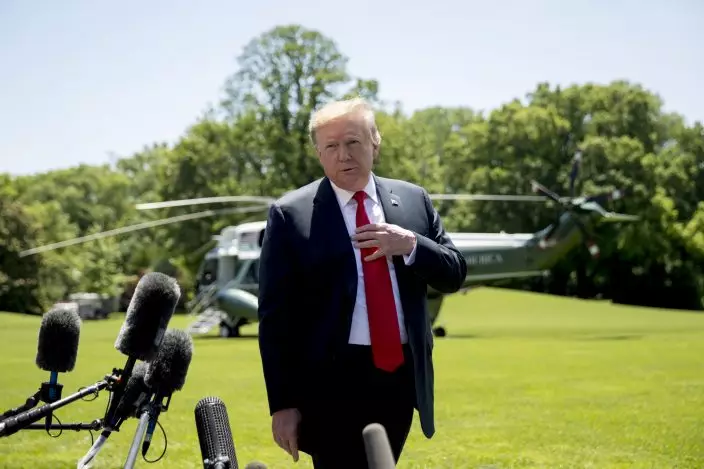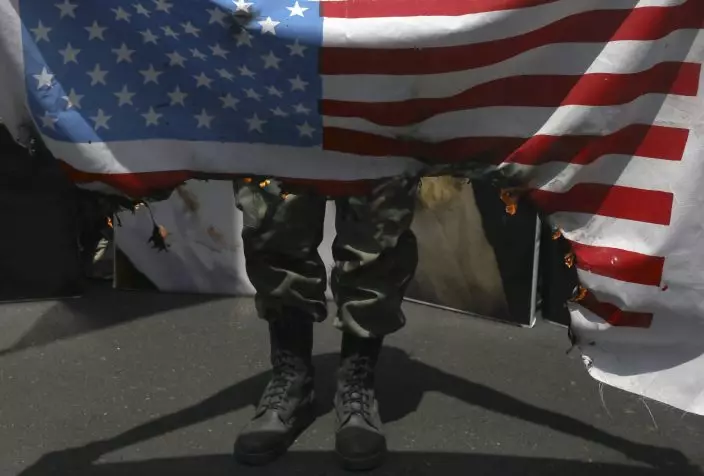Tensions between the United States and Iran have soared in recent weeks, with Washington dispatching warships and bombers around the Persian Gulf, and Tehran threatening to resume higher uranium enrichment. The tensions come a year after President Donald Trump withdrew from Iran's 2015 nuclear accord with world powers and restored crippling sanctions.
A timeline of recent events:
May 5: John Bolton, the White House national security adviser and a longtime Iran hawk, announces the deployment of the USS Abraham Lincoln carrier strike group and a bomber task force in response to "a number of troubling and escalatory indications and warnings," without providing details. He threatens "unrelenting force" in response to any attack.

FILE - In this May 24, 2019 file photo, President Donald Trump speaks to members of the media on the South Lawn of the White House in Washington, before boarding Marine One for a short trip to Andrews Air Force Base, Md., and then on to Tokyo. Trump said the U.S. will bolster its military presence in the Middle East with an additional 1,500 troops. He said the troops will have a "mostly protective" role. (AP PhotoAndrew Harnik, File)
May 8: Iran vows to enrich its uranium stockpile closer to weapons-grade levels, starting July 7, if world powers fail to negotiate new terms for its nuclear deal. The U.S. responds by imposing sanctions on Iran's metal industry.
May 9: The European Union urges Iran to respect the nuclear deal and says it plans to continue trading with the country despite U.S. sanctions. Trump says he would like Iran's leaders to "call me."
May 10: The U.S. says it will move a Patriot missile battery into the Middle East to counter threats from Iran.

FILE - In this file photo released May 22, 2019, by an official website of the office of the Iranian supreme leader, Supreme Leader Ayatollah Ali Khamenei attends a meeting with a group of students as they chant slogans, in Tehran, Iran. On May 14, 2019, Khamenei says "no one is seeking war," but that it wouldn't be difficult for Iran to enrich uranium to weapons-grade levels. (Office of the Iranian Supreme Leader via AP, File)
May 12: The United Arab Emirates says four commercial ships off its eastern coast "were subjected to sabotage operations," just hours after Iranian and Lebanese media outlets air false reports of explosions at a nearby Emirati port.
May 13: European foreign ministers urge the United States and Iran to show restraint, while U.S. Secretary of State Mike Pompeo briefs his counterparts on the alleged threats from Iran. Trump warns that if Tehran does "anything" in the form of an attack, "they will suffer greatly."
May 14: Yemen's Iran-aligned Houthi rebels launch a drone attack on Saudi Arabia, striking a major oil pipeline and taking it out of service.

FILE: In this June 1, 2019 file photo, Saudi King Salman chairs the Islamic Summit of the Organization of Islamic Cooperation (OIC) in Mecca, Saudi Arabia. May 31 and June 1 Salman hosts three high-level summits in Mecca, drawing heads of state from across the Middle East and Muslim countries to present a unified Muslim and Arab position on Iran. The monarch called on the international community to use all means to confront Iran and accuses the Shiite power of being behind "terrorist operations" that targeted Saudi oil interests. (AP PhotoAmr Nabil, File)
— The New York Times reports the White House is reviewing military plans that could result in sending 120,000 U.S. troops to the Middle East if Iran attacks American forces or steps up work on nuclear weapons. Trump says it's "fake news," but that he would "absolutely" be willing to send troops if necessary.
— Iran's Supreme Leader Ayatollah Ali Khamenei says "no one is seeking war," but that it wouldn't be difficult for Iran to enrich uranium to weapons-grade levels.
— A senior military officer in the U.S.-backed coalition fighting the Islamic State group says "there's been no increased threat from Iranian-backed forces in Iraq and Syria." In a rare public rebuttal, U.S. Central Command says his remarks "run counter to the identified credible threats."

FILE - In this May 7, 2019 file photo, U.S. Secretary of State Mike Pompeo, center, walks with Acting Assistant Secretary for Near Eastern Affairs at the State Department David Satterfield, left, and Charge D'affaires at the U.S. Embassy in Baghdad Joey Hood, second from left, and Lt. Gen. Paul LeCamera after arriving in Baghdad. Tensions between the United States and Iran have soared in recent weeks, with Washington dispatching warships and bombers around the Persian Gulf, and Tehran threatening to resume higher uranium enrichment. (Mandel NganPool Photo via AP, File)
May 15: The U.S. Embassy in Baghdad orders all nonessential government staff to leave Iraq immediately. The Netherlands and Germany say they are suspending their training of Iraqi forces.
May 16: Saudi Arabia blames Iran for the drone attack on its pipeline and an English-language newspaper close to the palace calls for the U.S. to launch "surgical" strikes in retaliation.
—Trump says he hopes the U.S. is not on a path to war with Iran amid fears that his two most hawkish advisers could be angling for a conflict with the Islamic Republic. Asked if the U.S. was going to war with Iran, the president replied, "I hope not" — a day after he repeated a desire for dialogue, tweeting, "I'm sure that Iran will want to talk soon."

FILE - In this Friday, May 31, 2019 file photo, a demonstrator burns a representation of the U.S. flag during the annual Quds, or Jerusalem Day rally as the Trump administration tries to offer an Israeli-Palestinian peace plan. in Tehran, Iran. (AP PhotoVahid Salemi, File)
May 19: A rocket lands near the U.S. Embassy in Baghdad, without harming anyone. It's not clear who is behind the attack, but after the initial reports, Trump tweets: "If Iran wants to fight, that will be the official end of Iran. Never threaten the United States again!" Iran's foreign minister responded by tweeting that Trump had been "goaded" into "genocidal taunts."
May 20: Semi-official media in Iran report that it has quadrupled its production of low-enriched uranium, which is used for civilian applications but not nuclear weapons. Iran is allowed to enrich uranium to the low level of 3.67%, but increased production could lead it to exceed the stockpile limits in the nuclear deal.
May 24: Trump says the U.S. will bolster its military presence in the Middle East with an additional 1,500 troops. He says the troops will have a "mostly protective" role.

FILE - In this Jan. 8, 2019 file photo, U.S. Secretary of State Mike Pompeo, and Jordan's Foreign Minister Ayman Safadi hold a press conference as Pompeo began a Mideast visit to talk to regional leaders about ramping up pressure on Iran, in Amman, Jordan. Tensions between the United States and Iran have soared in recent weeks, with Washington dispatching warships and bombers around the Persian Gulf, and Tehran threatening to resume higher uranium enrichment. (AP PhotoRaad Adayleh, File)
— Senior Pentagon officer Vice Admiral Michael Gilday says the U.S. has a high degree of confidence that Iran's Revolutionary Guard was responsible for the explosions of the four tankers in the Gulf of Oman, and that Iranian proxies in Iraq fired rockets into Baghdad.
May 31 and June 1: Saudi Arabia's King Salman hosts three high-level summits in Mecca, drawing heads of state from across the Middle East and Muslim countries to present a unified Muslim and Arab position on Iran. The monarch calls on the international community to use all means to confront Iran and accuses the Shiite power of being behind "terrorist operations" that targeted Saudi oil interests.
June 12: Saudi Arabia says 26 people were wounded in an attack by Yemen's Houthi rebels targeting an airport in kingdom's southwestern town of Abha. The Houthis claim they'd launched a cruise missile at the airport.
June 13: Two oil tankers near the strategic Strait of Hormuz are hit in an alleged assault that leaves one ablaze and adrift as 44 sailors are evacuated from both vessels and the U.S. Navy rushes to assist. America later blames Iran for the attack, something Tehran denies.
June 17: Iran says it will break the uranium stockpile limit set by Tehran's nuclear deal with world powers in the next 10 days.


